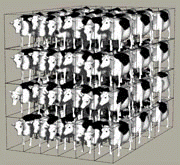Department of Animal Science
Date of this Version
1986
Abstract
Milk production in the temperate climates accounts for 66% of the world milk output. In North America only about 20% of beef originates from dairy herds, while in Europe beef production is a byproduct of dairying. Several studies showed small genetic correlations between milk and beef traits, thus suggesting the possibility of simultaneous selection for both .characteristics. European breeding programs include dual testing of bulls for milk and beef. Several experiments proved superiority of North American Holstein- Friesians over European dairy breeds in milk production. In the Polish Friesian strain comparison, the US strain, the Canadian strain and the Israeli Friesians produced 19%, 16% and 16% more milk, respectively, than the Polish Black and White strain. In fat yield New Zealand ranked together with Holsteins. The main disadvantage of crossing European breeds with North American dairy cattle is poorer beef quality. Further improvement of specialized dairy breeds is expected in North America. In Europe, the introduction of a milk quota system and the necessity of maintaining beef production may require re-assessment of current breeding strategies.


Comments
Published in 3rd World Congress on Genetics Applied to Livestock Production, edited by Gordon E. Dickerson and Rodger K. Johnson, 4 vols. (Lincoln: University of Nebraska Institute of Agriculture and Natural Resources, 1986). Copyright © 1986 Board of Regents University of Nebraska.